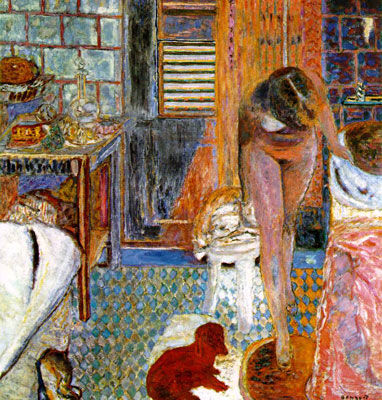Pierre Bonnard
- danicacardozo
- Mar 16, 2017
- 4 min read

He was a French painter and printmaker, as well as a founding member of the Post-Impressionist group of avant-garde painters Les Nabis. Bonnard preferred to work from memory, using drawings as a reference, and his paintings are often characterized by a dreamlike quality. The intimate domestic scenes, for which he is perhaps best known, often include his wife Marthe de Meligny.
Bonnard has been described as "the most thoroughly idiosyncratic of all the great twentieth-century painters", and the unusual vantage points of his compositions rely less on traditional modes of pictorial structure than voluptuous color, poetic allusions and visual wit. Identified as a late practitioner of Impressionism in the early 20th century, Bonnard has since been recognized for his unique use of color and his complex imagery. "It's not just the colors that radiate in a Bonnard", writes Roberta Smith, "there’s also the heat of mixed emotions, rubbed into smoothness, shrouded in chromatic veils and intensified by unexpected spatial conundrums and by elusive, uneasy figures."
Bonnard is known for his intense use of color, especially via areas built with small brush marks and close values. His often complex compositions—typically of sunlit interiors and gardens populated with friends and family members—are both narrative and autobiographical. Bonnard's fondness for depicting intimate scenes of everyday life, has led to him being called an "Intimist"; his wife Marthe was an ever-present subject over the course of several decades.
He painted several self-portraits, landscapes, street scenes, and many still lifes, which usually depicted flowers and fruit.Bonnard did not paint from life but rather drew his subject—sometimes photographing it as well—and made notes on the colors. He then painted the canvas in his studio from his notes.
For Bonnard, color was an end in itself - a way of experiencing the world. Color was so important to Bonnard that when he had mixed a color that was particularly to his liking, he would even go back and touch up other paintings with that color.
Bonnard painted many of his scenes from memory, capturing the spirit of the moment rather than the exact person or place. Bonnard did not paint from life but rather drew his subjects - sometimes photographing them as well - and made notes on the colors. He then painted - and especially, colored - the canvas in his studio from his notes.
HIS WORKS

The Toilet
Bonnard's bathroom and environs are known to have been very simple, plain, and functional. But in Bonnard's numerous bath scenes, spaces and objects have their own mystery and mood. Locked in her environment, the figure (Madame Bonnard) - the un-idealized, "modern" nude - is at one with her surroundings. It is an intimate scene in both subject matter, and the way the light caresses the objects, exposes their surfaces and highlighting the contours of the flesh. In contrast to his earlier fin-de-siècle work, the artist reanimates the space and gives depth to the scene, using tiles to shape it and modeling objects to make them appear more sensuous and tangible. As is usual in Bonnard's work, color creates the dominant effect, as the artist manipulates the oranges of the body and floor and the mauve of the wall and the legs to produce an aesthetically pleasing effect. Bonnard also uses luminous colors to produce a sensuous effect - a kind of nostalgic recollection of beauty and of the mystery of life. Since Bonnard is known to have worked largely from memory, this would be recollection at a distance, with objects taking on psychological qualities. Some of Bonnard's bath scenes even recall passages in Marcel Proust's Remembrance of Things Past.the painting would almost seem an Impressionist capturing of sunlight, except that the colors are more arbitrary and the space more compartmentalized than that of the Impressionists. Bonnard very carefully selects those objects upon which he wishes the viewer to focus. Some objects are intentionally out of focus, and some are intentionally in focus. Sometimes the figures even take a back seat to the objects. Rather than attempting the spontaneity of Impressionism, here Bonnard paints a figure performing a kind of habitual action - a figure in frozen permanence brought to mind through the act of memory acted upon by feeling.

Landscape at Le Cannet
Without the title, one might read this painting as being totally abstract, emphasizing as it does the flat surface of the painting rather than any depth of landscape. Its brushy shape areas are reminiscent of the work of Gauguin. Bonnard's treatment of this landscape in the south of France reminds us that shape does not have to be seen with an outline around it; shapes can be read as mere changes of color as we see here. Painted just two years before his death, this painting serves as an example of Bonnard's late work and follows the stylistic trajectory of increasing abstraction similar to that of late Monet and the Impressionists. Furthermore, it is fitting close to his earlier association with the group of Les Nabis. Bonnard took Maurice Denis's words further than any other member of this group: "A picture - before being a war horse, a female nude, or some anecdote - is essentially a flat surface covered with colors in a particular order."




Comments